Posted by Dave Bull at 7:57 PM, January 14, 2009
Carving work on the 'Seacoast in Winter' print is steadily progressing, interrupted as usual by any number of other jobs competing for attention. Today saw a pretty big one of those ...
A couple of months back, I did an inventory of my paper stock for this series, to work out how many more sheets I needed in order to complete the rest of the series, and placed an order with Iwano-san for them - 150 sheets of Echizen Hosho washi, in the 'takenaga' dimension. They arrived a few days ago, along with the bill, for 236,000 yen ... (around $2600 US at today's exchange rate ...)
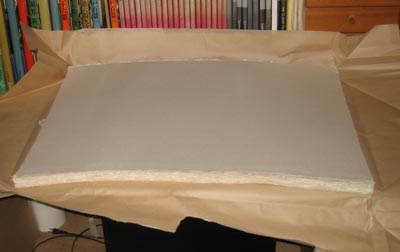
The paper in this 'raw' state cannot be used; it must be sized. This is a special skill all its own, and I will send this package straight off to Misawa-san, the last craftsman here in Tokyo who still does this work.
At least that's what I should be doing; unfortunately the process is no longer quite so simple. Here is a sample of a sheet from the previous batch of this same type of paper, which he sized for me just over a year ago:
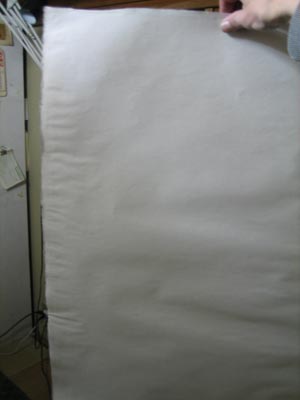
Incredible. The sizing was hard, brittle and uneven. The sheets were dried too quickly and became severely buckled and distorted. I called him right away to find out what had happened, but he had no excuse. It seems though, that the problem lay in the large width of these sheets. Sizing must be done in one continuous brush stroke across each sheet, and he has a collection of very large brushes for just this purpose.
But a brush this wide - full of hot size - is very heavy, and he is not so young ... It is also possible (this is just a guess) that his large brushes are getting worn out, and as he is nearing retirement, and a brush of this width would cost a great deal of money to have made to order, he is using them beyond the point where they can do the job properly.
Whatever the reason, the batch of paper had been effectively destroyed. Ordering more was out of the question; to throw away that much money was just not possible. I had to try and use it. I cut the paper into the smaller dimension required for the prints, and tried to salvage what I could. I used a shallow pan with warm water, soaked each sheet to try and wash out some of the size, and then dried each one on boards.
I got most of the worst of it out, but all through the rest of the printing work on the next few prints, kept getting results like this when I dried out the finished print:

So, what to do this time? I called him to discuss it, outlining clearly to him that there could be no repetition of the previous disaster. He suggested that cutting the sheets in half would make things go easier, as he could use a much smaller brush (working in single strokes along the narrow dimension of the half-sheets). This seemed like a reasonable option, until I asked him how this would affect the price for the job. (He is paid by the sheet, and the previous job had been priced at 150 yen per sheet.) He replied that the price wouldn't change; it would stay at 150 yen per sheet. My cost would thus double, as instead of 150 sheets at 150 yen each, I would now have 300 sheets at 150 yen each. When I protested that this was only happening because of his ... (I avoided using the word 'incompetence') ... he offered a 'discount'. He would do it for 130 yen per 'sheet', adding another 39,000 yen to my bill ... ($400+)
So, that's my job this afternoon and evening - cutting this paper in half ready for him to work on. Why such a long time just to cut 150 sheets of paper in half?
More fun and games ...
This paper is made in the traditional way, with the fibre mix dipped from the vat, and rocked on a bamboo screen. The structure of the screen is visible in the finished paper, in the form of 'laid lines' at approximately 3 cm intervals:
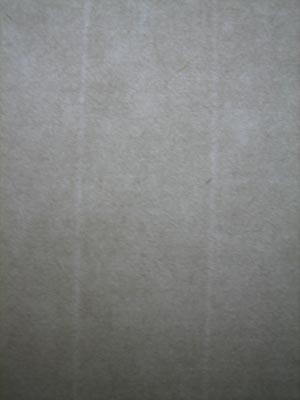
You can also see the faint lines in the image of the print above.
Back in the 'old days' (say, when I first came to Japan nearly 30 years ago) these lines were always perfectly ordered and parallel with the edges of the raw sheet. But more recently, this is not so. The equipment used by many of the papermakers, even famous ones like Iwano-san, is getting very old and rundown. It seems that the frame that this paper was rocked on is apparently no longer 'tight', and the lines left by the bamboo screen vary from one sheet to the next, sometimes perfectly vertical, sometimes leaning to one side or the other.
So if I stack the paper up and cut them a few dozen at a time, those lines in the paper will not be vertical on most of the finished prints. There is no way around it; I have to take the sheets one by one from the pile, place them on a dark surface so that I can see the faint lines, and then slice them at the correct angle to make the lines vertical in my finished prints ... 150 sheets, around a minute for each one ... a nice waste of nearly three hours ...
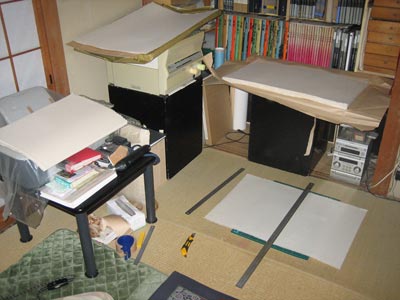
And how is the paper itself this time? Mixed.
It's useable, but there is plenty of bark still left in there - something that would have been inconceivable in paper from a 'Living National Treasure' not so very long ago ...
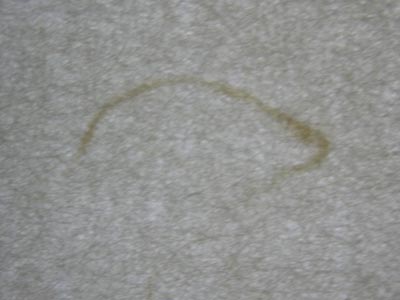
But enough complaining. It's not so bad, and it's still 'hosho washi'. The finished prints will still last hundreds of years, gradually developing a beautiful patina as they age ... (If I ever get them finished!)
I've been ordering most of my paper from U.S. distributors, so I'm many steps removed from the original sources and don't know who actually does the manufacturing of the paper or the sizing. I just learned some things from your post, though. Except for the non-parallel laid lines, I've seen the other problems to one degree or another -- the pieces of bark and the uneven sizing. One recent batch of paper showed brushstrokes from the sizing brush very clearly when wet. I had been blaming myself for the crinkling edges on some of my dried prints, but I see now that it may well have been a problem of uneven sizing.
Sad that these wonderful skills are being lost.

I had been blaming myself for the crinkling edges on some of my dried prints ...
Well, if it was crinkly before you started, then it's the sizing. If it crinkles only after you're done, then it's you ... (either you stretched the paper in places with baren pressure, or perhaps used too much paste - which shrinks when drying - or perhaps dried them too rapidly and unevenly ...)

David, perhaps you might add small seals in the margins that say, "this paper was made by..." and this paper was sized by..."?
I suspect that if these craftsmen knew their sloppy work was going to be so obvious to others in such a public way, they might think twice before taking advantage.
Cheers

add small seals in the margins
They both know already that they get very publicly credited with my work. On prints that are large enough, Iwano-san's name gets embossed right onto the paper. Misawa-san has to be content with an entry in the listing in the documentation that accompanies each set/album, but his name too is out there.
It makes no difference; these guys are working at the 'best' they can do ... it's not that they are particularly careless or bad, it's just the general decay of the whole enterprise of traditional woodblock printmaking here. Nothing immoral about it.
The only way it would turn around is if there were enough orders to: (1) put some competition back in the business, and (2) get the toolmakers back up and running (both those extra-large brushes, and the bamboo 'su' screens for making paper are now pretty much unobtainable at any price.)

David, thanks for the additional information. It's a shame that it's happening like this. Perhaps one day the government or Emperor can come up with a real world way to encourage young folks to take up these traditional roles.
Of course, even if they offered grants of lifetime employment including homes with workshops to young persons that undertake to preserve these interrelated and important skills, there would be no guarantee they could make a difference, or even entice enough new blood to try their hand at these critical tasks to keep them alive into the next generation.
To be truthful, I'm sort of surprised that, as popular as woodcut seems to be as a Japanese hobby, that it's come to this. I guess that 'lesser' materials and tools are good enough for most Japanese to enjoy their art, or am I completely off base?
Have machine made materials and tools closed the quality gap these last 25 years or is the decline across the entire spectrum of woodcut printmaking in Japan?

Perhaps the cheaper papers are no worse than this most expensive product. Perhaps the competitors are already offering a better product. Certainly the sizing is better on the down-market kozo papers I have tried. Still, I marvel at the stuff that finds its way into the paper, bark yes, but also human hair and most annoying are the minute metal filings that only become obvious once they rust after printing. I am bound to buckle the paper to get my inks to bite into the over-sized paper and I very rarely end up with a dead flat print, regardless of the care I take with pressing and drying. Still, these are the challenges that keep things interesting and I think that most of the flaws in my prints are due to me and my skills as a printer. Each edition is always a record of small failures and occasional triumph where everything is perfect. Hopefully the imperfections do not worry the customers.

government or Emperor
I myself don't think this has (or should have) anything to do with the government at all. Stuff changes. Prints once were popular; prints no longer are popular. Nothing 'wrong' there.
It's I who is the odd man out, by expecting things to 'stay the same'.
Have machine made materials and tools closed the quality gap
Some years back, when I was visiting Iwano-san the papermaker, I watched for a while as his wife, his mother, and his daughter-in-law worked cleaning bark particles off the fibre. They worked with their hands held under flowing ice water, picking the tiny particles off one by one.
I started to suggest a 'new' idea. "Look, we could build a machine to handle this sort of thing - the beaten fiber mix could pass through a little clear plastic pipe, a laser would shine down through, and as each dark piece of bark passed, a little gate could be triggered ... etc. etc."
He cut me off. "We're not interested. You want machine made paper? Go buy machine made paper. There is lots of it on the market."
I tried to make the point that there was an inbetween balance between the two extremes - the 100% by hand approach, and the 100% mechanical approach. "Just use the machines to do the part of the process that doesn't really benefit from human interaction. When I get the finished sheet, I don't care whether the particles were removed by laser, by your mother, or by black magic, just that they were removed. But the texture of the finished sheet depends very much on the skill of the man who dips, rocks, and couches it. Let the human do that part, assisted by mechanical methods for the 'rote' jobs."
But he wouldn't even discuss it.
I think at this point, the future here will be clearly market driven. I believe that a mechanical system could be built that would do a beautiful job of making a traditional printmaking paper - one indistinguishable from the best handmade paper ever created. But this could only come about if there were enough demand for such a product to allow for the (large) investment that would be necessary to design and build such a system. And the demand just isn't there.
If I didn't have six thousand other things going on, it is a project that I myself could be very interested in - I have a clear view of what is necessary in the end product, and I also have a smattering of engineering/programming knowledge.
But I just don't see it happening ... and if Iwano-san saw me talking like this, he would be upset, as he - obviously - doesn't believe that such a thing would be worth considering. And I would understand his point of view - after all, what if some kid came along and said to me, "Look, let's work out how to fix up a robotic arm that would hang over your workbench, and do the baren rubbing for you. It could have wonderfully sensitive sensors, and could be far more accurate than you can ever be ... " What would I say to him?

David, you're probably right about government involvement but it seem more than a little peculiar to me that, as a people that have seemingly put so much value on tradition and have identify skilled individuals working at traditional crafts and skills, as "Living National Treasures", they would not be more proactive in preserving the very skills and traditions they honor so.
If they, the Government, the Emperor, allow these skills to decline and be supplanted by other means and materials, or disappear altogether, how does have they served the next generations that are necessary to even have 'tradition' in the first place?
It's as if they're all on a speeding train and, looking out the window, they see these people at their labors, so, with a smile, a wave, a snapshot and a "isn't that nice," they shout out, "GOOD WORK!!!" and race by with only a fading memory and their photographs to remind them of what they passed on their way to a not too distant future where tradition is whatever happens to have survived, despite them and their deliberate indifference.
As far as a machine to pick out specks of trash, I think there are already a number of these type machines available and being used in industry. In fact, I think the first one I ever saw on TV was being used in Japan to cull out trash, bad grains, etc in rice.
Oh well, I do hope these skills and materials will be preserved and flourish into the future, but if there is no interest in either the market or by the Japanese peoples but it sure doesn't seem likely to this outsider, looking in.
Cheers

not be more proactive in preserving the very skills and traditions they honor so
Well, I guess my own viewpoint on this topic is probably not what you want to hear. As I wrote on one of the intro pages of this site, "I myself have not the slightest interest in 'preserving' any tradition, and to tell the truth, I don't think that traditions should be 'preserved'."
There's a bit more here ...

Hi Dave,
To be sure, I'm not even sure of what sizing is, and perhaps I'm being naive, but why not do it yourself? If the skill needed to apply sizing is greater the larger the surface to treat, then it doesn't seem that it would be that hard to develop the necessary skill to treat your own papers which are relatively small.
Best,
Marc

why not do it yourself?
This is where it is going to have to go ... eventually. Printer Numabe-san and I have discussed this, and Misawa-san has agreed to let us go over there and watch him work, and get a kind of 'tutorial' on some of the finer points. We already basically 'know' how to do it, and indeed, have done it ourselves sometimes. I did the sizing myself for the 'Yoshiwara Scene' print in one of my Surimono Albums.
The 'catch' is ... that it is a hugely difficult and delicate job. The temperature and thickness of the glue mixture will depend on the weather (humidity), the thickness of the paper being sized, and the requirements of the particular image being printed. The exact balance of alum/vs gelatin is extremely important - a tad too much alum, and pigment will not be absorbed properly when printing. (The paper I use recently whenever I - rarely - have to write a physical letter comes from the pile of spoiled sheets from that previous sizing attempt. It's nice and shiny!)
The very large brushes (up to around 60cm wide) have to be loaded with hot size, and then brushed in a single pass across the sheet - moving quickly at first as the brush dumps size, and then more slowly and more slowly as the brush becomes more empty.
Then, as you hang up the saturated sheets to dry, you gauge the 'feeling' in the air, and crack the windows open just a bit, or perhaps a bit more, or perhaps a bit wider, to ensure the proper slow rate of drying. But not too slow! Oh, and of course now that it's hung up, the size in the paper is starting to flow down through the sheet, so you put a bit more at one end to compensate for it ...
Etc. etc. etc.
It's insanely difficult to do a good job. It's a craft all its own, and it would take years to become more than basically competent. And in the meantime, how much paper is going to be spoiled!
But as I said, that's the future facing us anyway, so we might as well get started. Now let's see ... which of the other jobs on my table right now can be discarded, so that I can get started with this work ... ... ... :-(

Sizing would seem to be one of those jobs that really should be re-invented. Could sizing be sprayed onto the paper in an effective way, or does it need to be worked into the surface of the paper? I wish I had less sizing on all the paper I currently use except the cheapest which seems to be the most absorbent and easiest to print on. I have never experienced too little sizing always the opposite.

Here's a quote from the Wikipedia article about "Sizing":
Sizing is used on fibers during paper manufacture in order to curb their tendency to absorb liquids by capillary action. By doing so, sizing keeps the ink on the surface of the paper where it was intended to remain.
Ink was intended to remain on the surface of the paper? Most interesting. After all these years as a hanga collector, I didn't know that! ;-o
Marc

keeps the ink on the surface of the paper
I think the key word there is 'ink'. We don't use 'ink' at all in the Japanese tradition - the word implies oil-based materials, and ours are all water-base. Marc, you going to update the Wikipedia page to qualify the (mis)information?
Could sizing be sprayed onto the paper in an effective way?
You would think so, wouldn't you. I could easily imagine a simple machine with an efficient nozzle system spraying down (or maybe with rollers), that would put the 'perfect' amount of size onto the sheets. Again though, it only makes sense if it were done on a large scale ... Or perhaps what we need is for some young tech-savvy Japanese boy, who happens to also have an interest in traditional printmaking, to get excited about this, and build himself a workshop to make high-quality paper, using such tech assists.
Man, what would I give for paper like they had in the Meiji-era ... beautifully perfectly smooth, with no crap buried inside it ... And made without the use of 'slave labour'!

The first thing I was taught when I went to art school was how to strech paper. My how times have changed!
Dave I have big confidence that you can solve this problem.
In the meantime,
enjoy what you do








